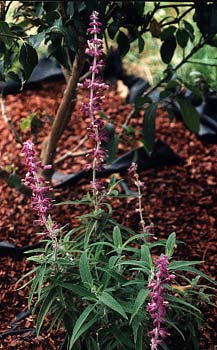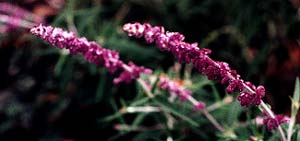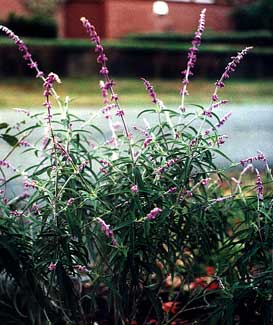
'Santa Barbara'
Dwarf Velvet Sage
"Into your garth this day I did persew;
There saw I flowris that fresche were of hew;
Baith quhyte and reid most lusty were to seyne,
And halesome herbis upon stalkis greene;
Yet leaf nor flowr find could I nane of rew."
-William Dunbar,
1465-1520
1465-1520
This Dwarf Velvet Sage (Salvia leucantha 'Santa Barbara') is only a dwarf on a comparative level. It can reach two feet tall plus long flower spikes bringing it to three feet high, & spreads into a four foot loose mound even with seasonal shearing to keep it fresh. The wild species of Velvet or Wooly sage would be larger still.
Our young specimen was about 18 inches tall in the July (2002) photo first on this page, when it was already flowering pleasingly. By October it had branched out into a substantial shrub with something of an octopus-appearance, each of its many tentacles tipped with flowers which lasted & lasted, even in our temperate Autumn & Winter. Mild frosts did not slow it down.
The second photo, below, was snapped in October. December through February it was still in full flower, but interestingly, around November, the very tips of the flowered stems were frosty white, as they had not been earlier in the year. This was actually the flowers finally beginning to die from the cold, but it was such a pure white that it remained quite lovely, as can be seen in the third photo snapped in early December. I clipped off the flowers as they whitened & faded, but at no time in the winter did the little bush cease to have a great many healthy blooms on it.
By February, it was still refreshing its blooms reliably. It was by then a three foot by four foot shrublet, & it might like to be tip-pruned to keep it compact, simultaneously obtaining a large late-winter bouquet for the kitchen. If one waits for it to stop blooming to prune it, it'll get rangy as you wait.
In our Puget Sound weather patterns, this dwarf velvet sage blooms July through February as though winter didn't exist, but then in early spring it is exhausted, stops blooming, & begins to die back, as one would expect most perennials to due in late autumn rather than at the tail-end of winter or beginning of spring. In March it might as well be cut to the ground, or quite soon nothing attractive will remain of it. It puts up a few new bits of growth in spring, but in general it will not have much of a presence again until June, then starts the process over again as a summer through winter bloomer.
I've other bush sages that bloom through winter, & it's my guess that this winter floweriness is because in their native desert environments they get used to being quite cold at night. But this one's winter performance vastly exceeds any others I've had experience with.
 It seems a curious life cycle that makes its "weak" season spring rather than winter, as though its seasonal timing were off a notch. Its winter vitality is probably dependent on the excellence of its grounds drainage, as only soggy soil can slow it down, which is why rainy spring rather than our mild winters induce some die-back.
It seems a curious life cycle that makes its "weak" season spring rather than winter, as though its seasonal timing were off a notch. Its winter vitality is probably dependent on the excellence of its grounds drainage, as only soggy soil can slow it down, which is why rainy spring rather than our mild winters induce some die-back.If a bad winter does harm it, it will grow back good as new, with damaged parts removed before start of spring. It'll bounce back even if pruned to the ground. When there is no winter damage, pruning could wait until early summer, & done mainly to keep the shrub compact & sturdy. In climates where it experiences no winter at all, it builds up over time into a substantially woody shrub with a year-round evergreen presence, but it can't quite do that for us here on Puget Sound.
The species (as opposed to the present cultivar) is sold as Wooly Sage or Mexican Bush Sage, greatly favored by hummingbirds & butterflies. It grows to four feet counting the flower spikes, or bigger. The cultivar 'Santa Barbara' has denser leafage for a more compact appearance than the species, but is even so not all that compact, providing an airy fountain.
 Its spikes of deep purple-blue flowers have the velvety texture that provides the species with the common names Wooly of Velvet. It loves bright sun & needs little or no watering other than provided by the sky. We got it for a low-maintance sun-garden along the street. Although it is a desert plant it easily adapts to cooler weather, just so long as it is strategically located to get as little as possible rainwater running down to it, placed in perfectly well-draining soil. It prefers poor soils to rich or humusy ones.
Its spikes of deep purple-blue flowers have the velvety texture that provides the species with the common names Wooly of Velvet. It loves bright sun & needs little or no watering other than provided by the sky. We got it for a low-maintance sun-garden along the street. Although it is a desert plant it easily adapts to cooler weather, just so long as it is strategically located to get as little as possible rainwater running down to it, placed in perfectly well-draining soil. It prefers poor soils to rich or humusy ones.It dislikes shade especially in our temperate zone & will become leggy & brittle if unhappy with its portion of sunlight. It can tolerate some shade in hotter climates than ours. In summer the flowering stems can become so heavy they are weighted down, but this makes for a pleasing fountaining look rather than fallen floppy look, & it is not necessary to stake 'Santa Barbara.'
It is a good companion plant with other low-maintance perennials & shrubs. Ours grows in the company of dwarf blue hyssop, sun roses, Hidcote Lavender, a nearby Butterfly Bush, & so on. Because it is an airy shrub it lets sunlight reach the ground, so does not hinder the succulent groundcovering Trailing Iceplant around the base of the sage. When this sun-garden was extended, 'Lambrook Gold' Euphorbia & an evergreen 'Aztec Pearl' Mexican Orange shrub were added nearby.
All was chosen so as to not require watering unless in a particularly long summer dry spell. The only plant that has been a bit of a problem is the Trailing Iceplant, which spreads up around the base of the Velvet Sage as a living mulch, holding in moisture the sage doesn't want, so I must very often weed back the Iceplant to bare the sage's root area to the sun.